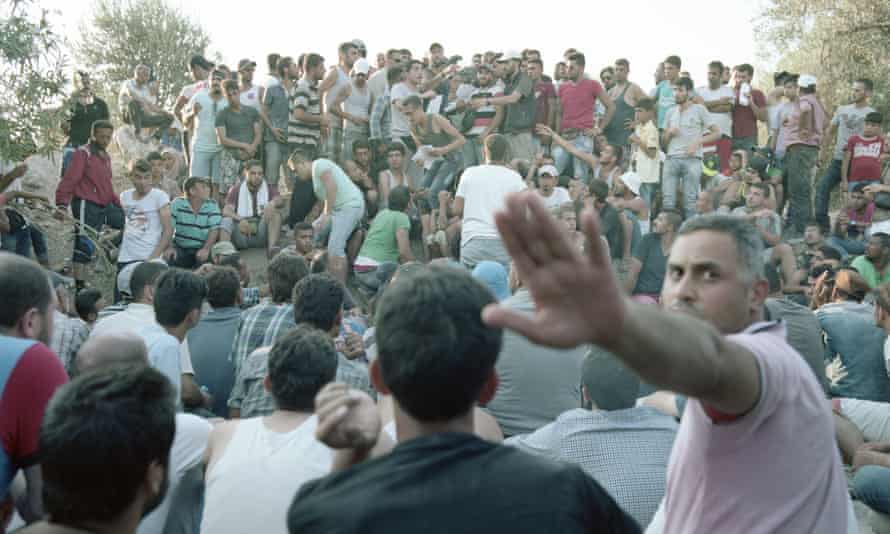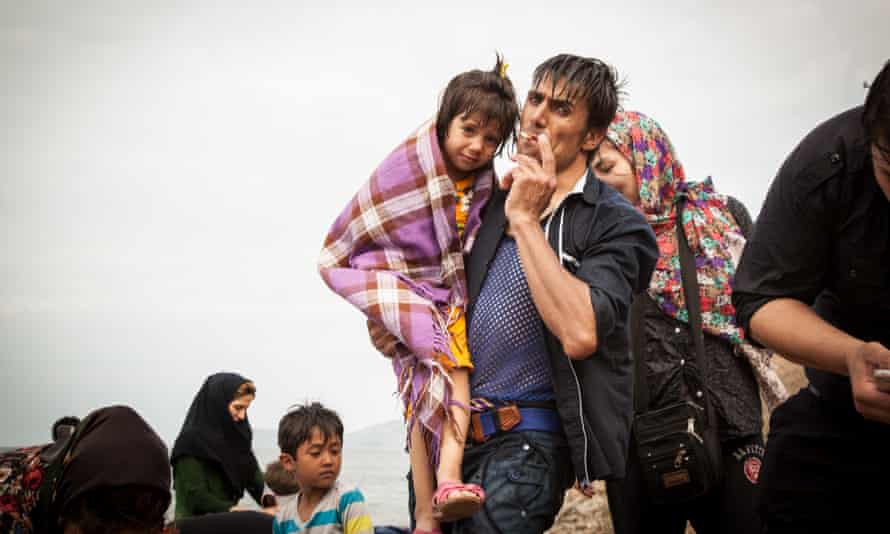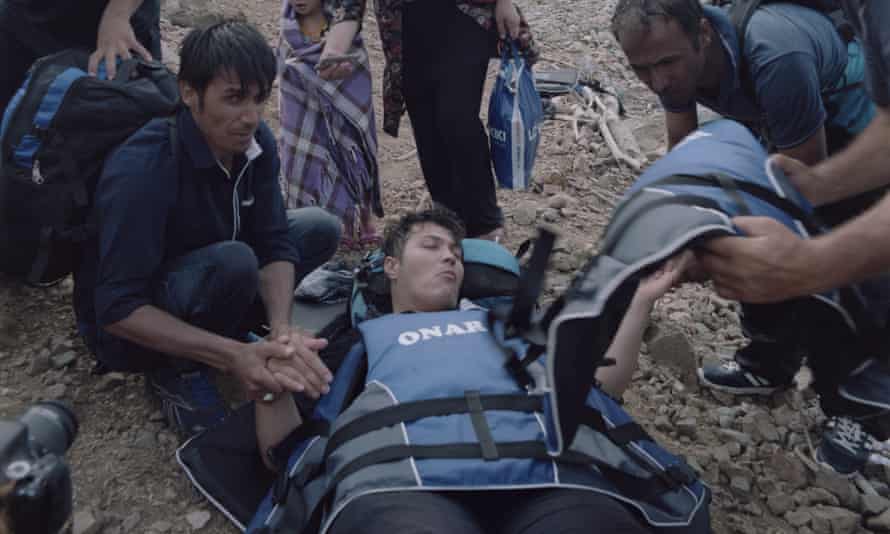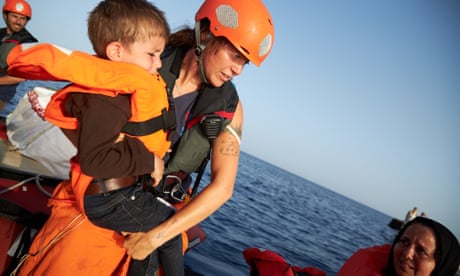 |
| A boat dangerrously overloaded with refugees lands near Molyvos on the Greak Island of Lesbos, July 2015. Photo by Jullian Edelstein |
How the media contributed to the migrant crisis
Disaster reporting plays to set ideas about people from ‘over there’.
Thursday 1 August 2019
When did you notice the word “migrant” start to take precedence over the many other terms applied to people on the move? For me it was in 2015, as the refugee crisis in Europe reached its peak. While debate raged over whether people crossing the Mediterranean via unofficial routes should be regarded as deserving candidates for European sympathy and protection, it seemed as if that word came to crowd out all others. Unlike the other terms, well-meaning or malicious, that might be applied to people in similar situations, this one word appears shorn of context; without even an im- or an em- attached to it to indicate that the people it describes have histories or futures. Instead, it implies an endless present: they are migrants, they move, it’s what they do. It’s a form of description that, until 2015, I might have expected to see more often in nature documentaries, applied to animals rather than human beings.
But only certain kinds of human beings. The professional who moves to a neighbouring city for work is not usually described as a migrant, and neither is the wealthy businessman who acquires new passports as easily as he moves his money around the world. It is most often applied to those people who fall foul of border control at the frontiers of the rich world, whether that’s in Europe, the US, Australia, South Africa or elsewhere. That’s because the terms that surround migration are inextricably bound up with power, as is the way in which our media organisations choose to disseminate them.
The people I met during the years I spent reporting on the experiences of refugees at Europe’s borders, for my book Lights in the Distance, were as keenly aware of this as any of us. There was the fixer I was introduced to in Bulgaria, a refugee himself, who was offering TV news crews a “menu” of stories of suffering, with a price range that corresponded with the value the media placed on them. Caesar, a young man from Mali I met in Sicily, told me he was shocked to find that Italian television would usually only show images of Africa in reports about war or poverty. Some refugees’ stories, he felt, were treated with more urgency than others because of what country they came from. Or there was Hakima, an Afghan woman who lived with her family in Athens, who confronted me directly: “We keep having journalists visit, and they want to hear our stories, but, tell me, what can you do?” Often, people I met were surprised at the lack of understanding, even indifference, they felt was being shown to them. Didn’t Europe know why people like them were forced to make these journeys? Hadn’t Europe played an intimate role in the histories and conflicts of their own countries?
Europe’s refugee crisis, or more properly, a disaster partly caused by European border policies, rather than simply the movement of refugees towards Europe, was one of the most heavily mediated world events of the past decade. It unfolded around the edges of a wealthy and technologically developed region, home to several major centres of the global media industry. Scenes of desperation, suffering and rescue that might normally be gathered by foreign correspondents in harder-to-access parts of the world were now readily available to reporters, news crews, filmmakers and artists at relatively low cost.
The people at the centre of the crisis were, at least for a time, relatively free to move around once they had reached safety and to speak to whoever they pleased. This gave certain advantages to the kind of media coverage that was produced. Most of all, it allowed quick and clear reporting on emergency situations as they developed. Throughout 2015, the crisis narrative was developed via a series of flashpoints at different locations within and around the European Union. In April, for example, attention focused on the smuggler boat route from Libya, after the deadliest shipwreck ever recorded in the Mediterranean. A month or so later focus shifted to Calais, where French and British policies of discouraging irregular migrants from attempting to cross the Channel had led to a growing spectacle of mass destitution. By the summer, the number of boat crossings from Turkey to Greece had dramatically increased, and images and stories of people stepping on to Aegean shores, or of piles of orange lifejackets, came to dominate. Then came the scenes of people moving through the Balkans, and so on, and so on.

In all of these situations the news media were able to do their basic job in emergency situations, which is to communicate what’s happening, who’s affected, what’s needed the most. But this is usually more than a matter of relaying dry facts and figures. “Human stories” have the greatest currency among journalists, although it’s an odd term if you think about it.
What stories aren’t human? In fact, it’s most commonly used to denote a particular kind of human story; one that gives individual experience the greatest prominence, that tells you what an event felt like, both physically and emotionally. It rests on the assumption that this is what connects most strongly with audiences: either because it hooks them in and keeps them watching or reading, or because it helps them identify with the protagonist, perhaps in a way that encourages empathy, or a particular course of action in response. As a result, the public was able to easily and quickly access vivid accounts and images of people’s experiences as they attempted to cross the EU’s external borders, or to find shelter and welcome within Europe.
 |
| Alan Kurdi |
The trade-off was that this often fit into predetermined ideas about what disasters look like, who needs protection, who is innocent and who is deserving of blame. Think, for example, about the most recognisable image of the refugee crisis in 2015: the picture of a Turkish police officer carrying the lifeless body of three-year-old Alan Kurdi away from the water’s edge on a beach near Bodrum.
As the Dutch documentary Een zee van beelden – A Sea of Images – (Medialogica, 2016) asked: why did this image in particular strike such a chord? After all, many news editors see images of death on a daily basis, yet for the most part decide to exclude them. The documentary showed how the apparently viral spread of the Alan Kurdi photograph on social media was in large part the result of a series of decisions taken by senior journalists and NGO workers.

First, a local photo agency in Turkey decided to release the image to the wires because they were so fed up with the lack of political response to the crisis on their shores. The image was shared by an official at a global human rights NGO with a large Twitter following, and retweeted by several prominent correspondents for large news organisations. Picture editors at several newspapers then decided, independently of one another, to place the photo on the front pages of their next editions; only after that point did it reach its widest circulation online. The image gained the status it did for a mix of reasons – political, commercial, but also aesthetic. One of the picture editors interviewed in the documentary commented on how the position of the figures in the photo resembled that of Michelangelo’s Pietà, an iconography of suffering and sacrifice that runs deep in European culture.
But if this way of working has its advantages, it also has its dark side. News media that rush from one crisis point to another are not so good at filling in the gaps, at explaining the obscured systems and long-term failures that might be behind a series of seemingly unconnected events. To return to the idea of a “refugee crisis”, for example, this is an accurate description in one sense, as it involved a sharp increase in the number of people claiming asylum in the European Union; from around 430,000 in 2013, according to the EU statistics agency Eurostat, to well over a million in 2015 and 2016 each. In global terms this was a relatively small number of refugees: the EU has a population of over 500 million, while most of the world’s 68.5 million forcibly displaced people are hosted in poorer parts of the world. But the manner of people’s arrival was chaotic and often deadly, while there was a widespread institutional failure to ensure that their needs – for basic necessities, for legal and political rights – were met. To stop there, however, risks giving the false impression that the crisis was a problem from elsewhere that landed unexpectedly on European shores.
This impression is false on two counts. First, Europe has played a key role, historically, in the shaping of a world where power and wealth are unequally distributed, and European powers continue to pursue military and arms trading policies that have caused or contributed to the conflicts and instability from which many people flee. Second, the crisis of 2015 was a direct effect of the complex and often violent system of policing immigration from outside the EU that has been constructed in the last few decades.
In short, this has involved the EU and its members signing treaties with countries outside its borders to control immigration on its behalf; an increasingly militarised frontier at the geographical edges of the EU; and an internal system for regulating the movement of asylum seekers that aims to force them to stay in the first EU country they enter. This, cumulatively, had the effect of forcing desperate people to take narrower and more dangerous routes by land and sea, while the prioritising of border control over safe and dignified reception conditions compounded the disaster. How well, really, did media organisations explain all this to their audiences?
The effect, all too often, was to frame these newly arrived people as others; people from “over there”, who had little to do with Europe itself and were strangers, antagonistic even, to its traditions and culture. This was true at times, of both well-meaning and hostile media coverage. A sympathetic portrayal of the displaced might focus on some of those images and stories that matched stereotypes of innocence and vulnerability: children, women, families; the vulnerable, the sick, the elderly.
Negative coverage, meanwhile, might focus more on the men, the able-bodied, nameless and sometimes faceless people massed at fences or gates. Or people from particular countries would be focused on to suit a political agenda. The Sun, one of Britain’s most widely read newspapers, for example, led with a picture of Alan Kurdi on its front page in September 2015, telling its readers that the refugee crisis was a matter of life and death, and that the immediate action required was further British military intervention in Syria. A few weeks later it gave another refugee boat story the front page, but in contrast to the earlier one the language was about “illegals” who were seeking a “back door”. This time, the refugees were from Iraq, and they had landed on the territory of a British air force base in Cyprus, which legally made them the responsibility of the UK.
The fragmented and contradictory media coverage of the crisis left room for questions to go unanswered and myths to circulate: who are these people and what do they want from us? Why don’t they stop in the first safe country they reach? Why don’t the men stay behind and fight? How can we make room for everyone? Are they bringing their problems to our shores? Do they threaten our culture and values? The problem is made worse by those media outlets that have an active desire to stoke hostility and misunderstanding.
One of the first people I met in the course of my reporting was Azad, a young Kurdish man from northern Syria, in a hastily constructed refugee camp in Bulgaria at the end of 2013. At the time, the inability of Bulgarian and EU authorities to adequately prepare for the arrival of a few thousand people – the camp, at Harmanli in southern Bulgaria, marked the first time Médecins sans Frontières had ever set up emergency medical facilities within Europe – seemed like an unusual development. Everyone was new to this situation, and the camp’s inhabitants, largely Syrians who had fled the war there but decided that Syria’s neighbouring countries could not offer them the security they needed, were shocked at what they found. Several of them told me this couldn’t possibly be the real Europe, and that they would continue moving until they found it. Azad was friendly and wanted to know lots about where I came from, London, and to find out what he could about the other countries in Europe, and where people like him might find a place to settle.
I went back to meet Azad several times over the next two years, as he and his family made their way across Bulgaria, and then central Europe, to Germany. During that time, the backlash against refugees grew stronger, a fact Azad was keenly aware of. In Sofia, in the spring of 2014, he pointed out places in the city centre where homeless Syrians had been attacked by street gangs. Later that year, in eastern Germany, we walked through a town where lampposts were festooned with posters for a far-right political party.

By the autumn of 2015, Azad and his family were settled in Germany’s Ruhr area, and he was much warier of me than he had been in our early meetings. He could see that hostility ran alongside the curiosity and welcome that had greeted the new arrivals to Europe; and he knew how giving too many details away to journalists could threaten what stability people in his situation had managed to find. Within a few months, a series of events – the Islamic State attack in Paris in November 2015, the robberies and sexual assaults in Cologne that New Year’s Eve – had provided the excuse for some media outlets to tie well-worn stereotypes about savage, dark foreigners and their alleged threat to white European purity to the refugees of today.
The most brazen of these claims – such as the Polish magazine wSieci, which featured a white woman draped in the EU flag being groped at by the arms of dark-skinned men, under the headline The Islamic Rape of Europe – directly echoed the Nazi and fascist propaganda of Europe’s 20th century. But racist stereotyping was present in more liberal outlets too. The Süddeutsche Zeitung, in its coverage of the Cologne attacks, prominently featured an illustration of a woman’s legs silhouetted in white, with the space in between taken up by a black arm and hand. Racism is buried so deep in European history that at times like these it can remain unspoken yet still make its presence clear.
Now, several years on from the peak of the refugee crisis, we are faced with a series of uncomfortable facts. The EU has tried to restore and strengthen the border system that existed before 2015 by extending migration control deep into Africa and Asia. The human rights of the people this affects, not least the many migrants trapped in horrendous conditions in Libya, are taking a back seat. Far right and nationalist movements have made electoral gains in many countries within the EU, and they have done this partly by promising to crack down on migration, to punish refugees for daring to ask for shelter from disasters that Europe was all too often the midwife to. Politicians of the centre are being pulled to the right by these developments, and a dangerous narrative threatens to push out all others: that European culture and identity are threatened by intrusions from outside. If we come to view culture in this way – as something fixed and tightly bounded by the ideologies of race and religion, or as a means for wealthy parts of the world to defend their privilege – then we are headed for further, greater disasters.
The irony is that you can only believe in this vision if you ignore not only Europe’s history, but its present too. Movement, exchange, new connections, the making and remaking of tradition – these things are happening all around us, and already involve people who have been drawn here from other parts of the world by ties not just of conflict but of economics, history, language and technology. By the same token, displacement is not just a feature of the lives of people from elsewhere in the world; it’s been a major and recent part of Europe’s history too. And what has kept people alive, what has preserved traditions and allowed people to build identities and realise their potential, is solidarity: the desire to defend one another and work towards common goals.
If there is a failure to recognise this, then the way people are represented by our media and cultural institutions has to be at fault, and setting this right is an urgent challenge. This isn’t only in terms of how people are represented and when, but who gets to participate in the decision-making; who gets to speak with authority, or with political intent, or with a collective voice rather than simply as an individual.
All too often, the voices of refugees and other marginalised people are reduced to pure testimony, which is then interpreted and contextualised on their behalf. One thing that constantly surprised me about the reporting on refugees in Europe, for instance, was how little we heard from journalists who had connections to already settled diaspora communities. Immigration from Africa, Asia or the Middle East is hardly new to Europe, and this seems like a missed opportunity to strengthen bridges we have already built. Though it’s never too late.
Any meaningful response to this has to address the question of who gets to tell stories, as well as what kinds of stories are told. The Refugee Journalism Project, a mentoring scheme for displaced journalists, based at London College of Communication – disclosure: I’m on the steering committee, and it is supported by the Guardian Foundation – focuses not only on providing people with a media platform, but helping them develop the skills and contacts necessary for getting jobs.
All too often the second part is forgotten about. But although initiatives like these are encouraging, we also need to rethink the way our media organisations are run: who owns them, who makes the decisions, who does the work. This reminds me of what I heard Fatima, a women’s rights activist originally from Nigeria, tell an audience of NGO workers in Italy in 2016: “Don’t just come and ask me questions and sell my story or sell my voice; we need a change.”
The more those of us who work in media can help develop the connections that already exist between us, the more I think we can break down the idea of irreconcilable conflict over migration. Because, really, there is no “over there” – just where we are.
THE GUARDIAN


No comments:
Post a Comment